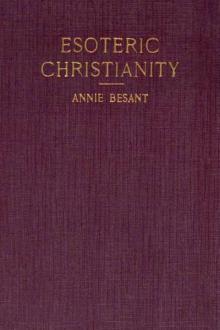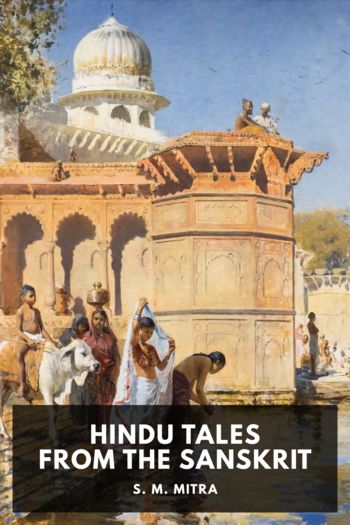Esoteric Christianity, Annie Besant [good short books txt] 📗

- Author: Annie Besant
- Performer: -
Book online «Esoteric Christianity, Annie Besant [good short books txt] 📗». Author Annie Besant
These events are reproduced in the lives of the various Solar Gods, and antiquity teems with illustrations of them. Isis of Egypt like Mary of Bethlehem was our Immaculate Lady, Star of the Sea, Queen of Heaven, Mother of God. We see her in pictures standing on the crescent moon, star-crowned; she nurses her child Horus, and the cross appears on the back of the seat in which he sits on his mother's knee. The Virgo of the Zodiac is represented in ancient drawings as a woman suckling a child—the type of all future Madonnas with their divine Babes, showing the origin of the symbol. Devakî is likewise figured with the divine Kṛiṣhṇa in her arms, as is Mylitta, or Istar, of Babylon, also with the recurrent crown of stars, and with her child Tammuz on her knee. Mercury and Æsculapius, Bacchus and Hercules, Perseus and the Dioscuri, Mithras and Zarathustra, were all of divine and human birth.
The relation of the winter solstice to Jesus is also significant. The birth of Mithras was celebrated in the winter solstice with great rejoicings, and Horus was also then born: "His birth is one of the greatest mysteries of the [Egyptian] religion. Pictures representing it appeared on the walls of temples.... He was the child of Deity. At Christmas time, or that answering to our festival, his image was brought out of the sanctuary with peculiar ceremonies, as the image of the infant Bambino is still brought out and exhibited at Rome."[180]
On the fixing of the 25th December as the birthday of Jesus, Williamson has the following: "All Christians know that the 25th December is now the recognised festival of the birth of Jesus, but few are aware that this has not always been so. There have been, it is said, one hundred and thirty-six different dates fixed on by different Christian sects. Lightfoot gives it as 15th September, others as in February or August. Epiphanius mentions two sects, one celebrating it in June, the other in July. The matter was finally settled by Pope Julius I., in 337 A.D., and S. Chrysostom, writing in 390, says: 'On this day [i.e. 25th December] also the birth of Christ was lately fixed at Rome, in order that while the heathen were busy with their ceremonies [the Brumalia, in honour of Bacchus] the Christians might perform their rites undisturbed.' Gibbon in his Decline and Fall of the Roman Empire, writes: 'The [Christian] Romans, as ignorant as their brethren of the real date of his [Christ's birth] fixed the solemn festival to the 25th December, the Brumalia or winter solstice, when the Pagans annually celebrated the birth of the Sun.' King, in his Gnostics and their Remains, also says: 'The ancient festival held on the 25th December in honour of the birthday of the Invincible One,[181] and celebrated by the great games at the Circus, was afterwards transferred to the commemoration of the birth of Christ, the precise date of which many of the Fathers confess was then unknown;' while at the present day Canon Farrar writes that 'all attempts to discover the month and day of the nativity are useless. No data whatever exist to enable us to determine them with even approximate accuracy.' From the foregoing it is apparent that the great festival of the winter solstice has been celebrated during past ages, and in widely separated lands, in honour of the birth of a God, who is almost invariably alluded to as a 'Saviour,' and whose mother is referred to as a pure virgin. The striking resemblances, too, which have been instanced not only in the birth but in the life of so many of these Saviour-Gods are far too numerous to be accounted for by any mere coincidence."[182]
In the case of the Lord Buddha we may see how a myth attaches itself to a historical personage. The story of His life is well known, and in the current Indian accounts the birth-story is simple and human. But in the Chinese account He is born of a virgin, Mâyâdevî, the archaic myth finding in Him a new Hero.
Williamson also tells us that fires were and are lighted on the 25th December on the hills among Keltic peoples, and these are still known among the Irish and the Scotch Highlanders as Bheil or Baaltinne, the fires thus bearing the name of Bel, Bal, or Baal, their ancient Deity, the Sun-God, though now lighted in honour of Christ.[183]
Rightly considered, the Christmas festival should take on new elements of rejoicing and of sacredness, when the lovers of Christ see in it the repetition of an ancient solemnity, see it stretching all the world over, and far, far back into dim antiquity; so that the Christmas bells are ringing throughout human history, and sound musically out of the far-off night of time. Not in exclusive possession, but in universal acceptance, is found the hallmark of truth.
The death-date, as said above, is not a fixed one, like the birth-date. The date of the death is calculated by the relative positions of Sun and Moon at the spring equinox, varying with each year, and the death-date of each Solar Hero is found to be celebrated in this connection. The animal adopted as the symbol of the Hero is the sign of the Zodiac in which the Sun is at the vernal equinox of his age, and this varies with the precession of the equinoxes. Oannes of Assyria had the sign of Pisces, the Fish, and is thus figured. Mithra is in Taurus, and, therefore, rides on a Bull, and Osiris was worshipped as Osiris-Apis, or Serapis, the Bull. Merodach of Babylon was worshipped as a Bull, as was Astarte of Syria. When the Sun is in the sign of Aries, the Ram or Lamb, we have Osiris again as Ram, and so also Astarte, and Jupiter Ammon, and it is this same animal that became the symbol of Jesus—the Lamb of God. The use of the Lamb as His symbol, often leaning on a cross, is common in the sculptures of the catacombs. On this Williamson says: "In the course of time the Lamb was represented on the cross, but it was not until the sixth synod of Constantinople, held about the year 680, that it was ordained that instead of the ancient symbol, the figure of a man fastened to a cross should be represented. This canon was confirmed by Pope Adrian I."[184] The very ancient Pisces is also assigned to Jesus, and He is thus pictured in the catacombs.
The death and resurrection of the Solar Hero at or about the vernal equinox is as wide-spread as his birth at the winter solstice. Osiris was then slain by Typhon, and He is pictured on the circle of the horizon, with outstretched arms, as if crucified—a posture originally of benediction, not of suffering. The death of Tammuz was annually bewailed at the spring equinox in Babylonia and Syria, as were Adonis in Syria and Greece, and Attis in Phrygia, pictured "as a man fastened with a lamb at the foot."[185] Mithras' death was similarly celebrated in Persia, and that of Bacchus and Dionysius—one and the same—in Greece. In Mexico the same idea re-appears, as usual accompanied with the cross.
In all these cases the mourning for the death is immediately followed by the rejoicing over the resurrection, and on this it is interesting to notice that the name of Easter has been traced to the virgin-mother of the slain Tammuz, Ishtar.[186]
It is interesting also to notice that the fast preceding the death at the vernal equinox,—the modern Lent—is found in Mexico, Egypt, Persia, Babylon, Assyria, Asia Minor, in some cases definitely for forty days.[187]
In the Pseudo-Mysteries, the Sun-God story was dramatised, and in the ancient Mysteries it was lived by the Initiate, and hence the solar "myths" and the great facts of Initiation became interwoven together. Hence when the Master Christ became the Christ of the Mysteries, the legends of the older Heroes of those Mysteries gathered round Him, and the stories were again recited with the latest divine Teacher as the representative of the Logos in the Sun. Then the festival of His nativity became the immemorial date when the Sun was born of the Virgin, when the midnight sky was filled with the rejoicing hosts of the celestials, and
Very early, very early, Christ was born.
As the great legend of the Sun gathered round Him, the sign of the Lamb became that of His crucifixion as the sign of the Virgin had become that of His birth. We have seen that the Bull was sacred to Mithras and the Fish to Oannes, and that the Lamb was sacred to Christ, and for the same reason; it was the sign of the spring equinox, at the period of history in which He crossed the great circle of the horizon, was "crucified in space."
These Sun myths, ever recurring throughout the ages, with a different name for their Hero in each new recension, cannot pass unrecognised by the student, though they may naturally and rightly be ignored by the devotee; and when they are used as a weapon to mutilate or destroy the majestic figure of the Christ, they must be met, not by denying the facts, but by understanding the deeper meaning of the stories, the spiritual truths that the legends expressed under a veil.
Why have these legends mingled with the history of Jesus, and crystallised round Him, as a historical personage? These are really the stories not of a particular individual named Jesus but of the universal Christ; of a Man who symbolised a Divine Being, and who represented a fundamental truth in nature; a Man who filled a certain office and held a certain characteristic position towards humanity; standing towards humanity in a special relationship, renewed age after age, as generation succeeded generation, as race gave way to race. Hence He was, as are all such, the "Son of Man," a peculiar and distinctive title, the title of an office, not of an individual. The Christ of the Solar Myth was the Christ of the Mysteries, and we find the secret of the mythic in the mystic Christ.





Comments (0)